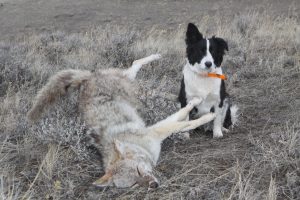It wasn’t a surprise, but I kicked myself for not toting my Bergara rifle the other day. Cabin fever had gotten the best of me, and I decided to go for a hike with the goal of picking up a shed deer antler. The surprise came in the form of a coyote just staring at me from 200 yards away. That’s a shot I can usually make with ease from a sturdy rest. Actually, the coyote wasn’t staring at me; it was locked on my dog, who was scent-tracking the coyote up the steep hill.
I whistled for my dog to come back to my side, and we walked off with the coyote still statuesquely glaring at us for the territorial invasion.
Do you like to hike rather than sit at setup sites and wait for coyotes to come to you? Consider taking your dog for a walk as spring arrives.
Related: How to Transition Your Dog from Training to Hunting
Most coyotes are bred and establishing den sites this time of year. They are also enforcing territorial boundaries at this time. Duties have transitioned from survival to parenting. Because of this behavioral shift, they scrutinize the moves of any canines in their homelands and may challenge the intruders.
To capitalize on this character, you can take your dog for a walk and use it to focus attention away from you. This may sound like a hair-brain idea, but I’ve had close encounters with coyotes dozens of times during my annual hikes to look for dropped deer and elk antlers. Because of this behavior, and when added weight isn’t an issue, I’ve also toted along my rifle and taken advantage of this seasonal behavior. Some coyotes circle cautiously, while others charge in to handgun range. Almost all are in range for a tightly-tuned predator rifle.
If you do decide to take the dog for a walk, focus on coyote-rich areas. You can take your hike at any time of the day as coyotes stay on guard 24/7 now with pups in the picture. You can also combine your walk with other activities like checking property boundaries, scouting future setup sites or even picking up antlers like me.
It’s imperative that your accompanying dog is fit enough to make the hike. It’s even more imperative that it listens to your commands. If it is a hunting dog and is used to a training collar, by all means, use it. A charging coyote may be too much for a dog to take emotionally. Having your dog return the charge could lead to the coyote leaving or worse — an all-out fight.
Hike slowly through your hunting area and stay in the open as much as possible. Scan ridge tops and high points for signs of coyotes staring down at you. Heel your dog and slowly move closer if you need to decrease the shot distance. Then, make your dog move a few feet away so the shot doesn’t blow its eardrums out.
I know this entire strategy sounds crazy, but from my experience it works. And even if you don’t tease a coyote, you still have accomplished one goal. The dog walk is over for the day.
Do you use your dog for coyote hunting? Or have you ever had a coyote or other predator charge your dog on a walk? Comment below and let us know.







